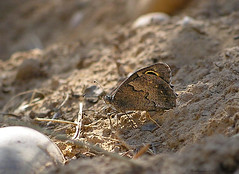
Hipparchia (Neohipparchia) statilinus /
Sátiro moreno /
Tree Gray (Hufnagel 1766)
Cargado originalmente por Macrodomo
(Id. Por Enrique García-Barros en Insectarium Virtual)
* Reino: Metazoa
* Subreino: Eumetazoa
* Rama: Bilateria
* Grado: Coelomata
* Serie: Protostomia
* Phylum: Arthropoda
* Subphylum: Mandibulata
* Clase: Insecta
* Subclase: Holometabola
* Orden: Lepidoptera
* Suborden: Glossata
* Infraorden: Neolepidoptera
* Superfamilia: Papilionoidea
* Familia: Nymphalidae
* Subfamilia: Satyrinae
* Genero: Neohipparchia
* Especie: statilinus
Aunque es una mariposa que puede llegar a ser común de forma local, en general, se está haciendo cada vez más rara por la progresiva destrucción de su hábitat.
Aparecen entre julio y octubre, los machos antes que las hembras, sobre brezales y lugares rocosos de las laderas de las montañas, en el centro y sur de Europa, y en el oeste de Asia.
Superan los cinco centímetros de tamaño. Por la cara superior, las alas son de color pardo grisáceo, más claras hacia el borde exterior; las anteriores presentan dos puntos negros y entre ellos dos blancos más pequeños. Por la cara inferior, son más claras y emborronadas, con líneas negras en zig-zag, el primero de los puntos negros aparece como un ocelo negro enmarcado en naranja, también son visibles el otro punto negro y los dos puntitos blancos.
La oruga es amarilla, rayada de marrón, y pasa el invierno al pie de las hierbas de las que se alimenta, principalmente de los géneros Festuca y Poa.
(Animalandia)
Although it is a butterfly that can become common locally, in general, it is becoming more and more rare for the progressive destruction of his habitat.
They appear between July and October, the males before the females, on heaths and rocky places of the hillsides of the mountains, in the center and south of Europe, and in the west of Asia.
They overcome five centimeters of size. For the top face, the wings are of brown greyish color, lighter towards the exterior rim; the forewings present two black points and between them two smaller in white. For the low face, they are clearer and made blots, with black lines in zigzag, the first one of the black points appears as a black ocelo framed in orange, also are visible another black point and two little white points.
The caterpillar is yellow, stripped of brown, and spend the winter on the foot of their nutritial grasses , mostlly of the genres Festuce and Poa.
(From Aimalandia)
No hay comentarios:
Publicar un comentario